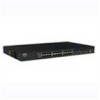Dell PowerConnect 5324 User's Guide - Page 241
Specifies the device Maximum Age Time. The Maximum Age Time indicates, Disables Spanning Tree
 |
View all Dell PowerConnect 5324 manuals
Add to My Manuals
Save this manual to your list of manuals |
Page 241 highlights
- Enable - Enables Spanning Tree - Disable - Disables Spanning Tree STP Operation Mode - The STP mode by which STP is enabled on the device. The possible field values are: Classic STP - Enables Classic STP on the device. This is the default value. Rapid STP - Enables Rapid STP on the device. Port Cost Method - Determines the Spanning Tree default path cost method. The possible field values are: Short - Specifies 1 through 65535 range for port path costs. This is the default value. Long - Specifies 1 through 200000000 range for port path costs. BPDU Handling - Determines how BPDU packets are managed when STP is disabled on the port/ device. BPDUs are used to transmit spanning tree information. The possible field values are: Filtering - Filters BPDU packets when spanning tree is disabled on an interface. Flooding - Floods BPDU packets when spanning tree is disabled on an interface. This is the default value. Priority (0- ) - Specifies the bridge priority value. When switches or bridges are running STP, each is assigned a priority. After exchanging BPDUs, the switch with the lowest priority value becomes the Root Bridge. The default value is 32768. The bridge priority value is provided in increments of 4096 (4K increments). For example, 0, 4096, 8192, etc. Hello Time (1-10) - Specifies the device Hello Time. The Hello Time indicates the amount of time in seconds a root bridge waits between configuration messages. The default is 2 seconds. Max Age (6-40) - Specifies the device Maximum Age Time. The Maximum Age Time indicates the amount of time in seconds a bridge waits before sending configuration messages. The default max age is 20 seconds. Forward Delay (4-30) - Specifies the device forward delay time. The Forward Delay Time indicates the amount of time in seconds a bridge remains in a listening and learning state before forwarding packets. The default is seconds. Bridge ID - Identifies the Bridge priority and MAC address. Root Bridge ID - Identifies the Root Bridge priority and MAC address. Root Port - The port number that offers the lowest cost path from this bridge to the Root Bridge. It is significant when the Bridge is not the Root. The default is zero. Root Path Cost - The cost of the path from this bridge to the root. Topology Changes Counts - Specifies the total amount of STP state changes that have occurred since the last reboot. Configuring Device Information 241















